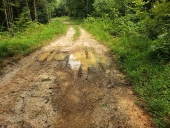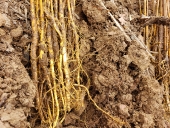posted 4 years ago
It is a bit of a mental balancing act, for sure. I haven't quite found peace with some of the "invasive" plants around me, but I've gotten far better with it. In the past, I would almost obsessively pull garlic mustard and honeysuckle whenever I found them. People that walked behind me on park trails probably wondered why they were finding all those poor plants hanging upside down in the too big to pull honeysuckle. Sometimes I still pull them when I'm out walking if it looks like the area is otherwise free of them.
When we found the land we steward and live on now, it was basically all bush honeysuckle, euonymus, oriental bittersweet, English ivy, garlic mustard and Japanese knotweed. There were some cool natives hanging on for dear life. At first, I felt overwhelmed with all the invasive plants we needed to remove and somewhat guilty for letting them be there. We did start working on the knotweed, honeysuckle and a few others right away. But there are so many honeysuckle and they're massive ones. We didn't want to clear cut it. And I was completely unwilling to use poison, as most people in my life were telling me I had to. I feel that would've been far more harmful than the plants. But removing that many plants with two people and hand tools is hard and time consuming! So I had to find a way to accept that it will be a several years long process to remove all of it.
I started referring to them as "highly successful and extremely bad at sharing" instead of "invasive" (though for simplicity, I'll use invasive here). After all, it isn't their fault they're here. Nor is it their fault that humans disturbed the ecosystem and brought new beings in who would obviously have a great advantage.
I also started thinking about what roles those plants were playing. I saw that the knotweed was doing some hard work breaking up crazy clay and adding tons of biomass. And the honeysuckle is creating a really tucked away little place for us and wildlife. This let me feel some gratitude for them, in a way. Ultimately, I'd still rather have native plants do the jobs they're doing. But I don't feel like I need to guilt myself or burn myself out trying to get rid of all the invasives right away. I don't feel like removing such a large part of the flora all at once is really respectful or responsible in my situation. I do make my best effort to prevent the invasives from spreading any further by preventing them from making seeds whenever I can. The knotweed I don't allow to spread under any circumstance.
Since I didn't just cut it all down, I got to observe that at least in one case, a native plant was actually working to restore the balance. There are tons of native grapes that are climbing into the honeysuckle and preventing it from getting enough light. The ones with grape, you can't see any honeysuckle foliage, they no longer fruit and are slowly dying. I have been aiding the grapes by girdling those honeysuckle. I may try to give grapes the advantage on other ones by chopping and/or girdling. That way, there are still "shrubs" and the birds can benefit from those (sort of) and moreso, from the grapes.
We have done a lot of work, but I'd say we've probably only removed 1/3 or less of the honeysuckle and the knotweed battle continues after three years of pulling it whenever we see it. But even just doing some of that work, so much biodiversity has returned! So many things showed up from the seed bank once we opened up just some of the sun light again. Plants I've never even seen in my area. And the birds and insects love it here! So your efforts don't have to be perfect to help the land.
The way I see it, removing plants that don't allow for diversity is probably a good move. Especially since that often means harm to wildlife who rely on the native plants for food. But removing "invasives" by any means and with no consideration of how removing them would affect the ecosystem they've been part of isn't always best. Observation and patience with yourself and the situation can help.
“Action on behalf of life transforms. Because the relationship between self and the world is reciprocal, it is not a question of first getting enlightened or saved and then acting. As we work to heal the earth, the earth heals us.” ~ Robin Wall Kimmerer

 2
2







 11
11




 7
7




 2
2




 5
5




 6
6




 2
2




 1
1





 3
3




 2
2












